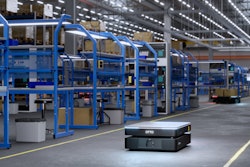
Competition is everywhere. From choosing between electric, hybrid and traditional gas cars to determining if a sugar cone, cake cone or waffle cone should hold that next scoop of ice cream, a little competition isn’t bad for the market or the end consumer.
While companies are on the path to best answering customer needs driven by consumer demand, getting to that end result could overlook some territory, like their supply chain and each touchpoint. From how goods are packaged and transported to which materials can be reused or recycled, food manufacturers have a unique opportunity to influence how the broader market approaches environmentally friendly initiatives.
Let’s look at a few collaborative steps food manufacturers can take to reduce environmental impact and think regeneratively.
Agreeing to prioritize sustainability
Before collaboration can happen, all stakeholders (even competitors) need a common goal. So, how did sustainability become a shared commitment across the food industry?
Some food and beverage manufacturers were ahead of the curve and always thinking sustainably. However, many adopted eco-conscious goals rapidly in the past few years as consumers began demanding more from their favorite brands. This was born from the pandemic’s temporary pause on the world, which saw fewer cars on the road, non-essential manufacturing shut down and leisure travel was nearly at a standstill which, combined and individually, reduced carbon emissions.
Studies around the world put numbers to the phenomenon. For example, the University of California, Los Angeles, found a 30% decrease in nitrogen oxides as traffic disappeared. Of course, that statistic only lasted as long as lockdowns did, which was and still is an unsustainable solution in the pursuit of sustainability and positive environmental change.
Though the reduction was temporary, many food and beverage manufacturers continued to prioritize sustainability targets as they returned to normal operations. There was no other path forward, after seeing a glimpse of a more eco-conscious system and its benefits to the world, as well as a notable shift in consumer preference for purpose-driven brands.
Friendly competition meets transport collaboration
The mantra of friendly competition usually stops in its tracks when it comes to business strategy. Typically, you wouldn’t consider sharing your operational strategies with competitors. The sustainability challenges, however, call for creative thinking. What if, instead of driving empty miles and contributing to carbon emissions, competitors worked together to share their transport loads?
Some food retailers have already taken this step with a process called transport collaboration. Here’s how it works: a particular retailer works with a third-party to understand where its transport lanes overlap with other manufacturers, even competitors, and how they could most efficiently share space on a single truck. Competitors in the market are now partners for the planet with one manufacturer making the delivery, saving both businesses money and eliminating the empty miles driven by their competitor. The savings can be substantial as this example can potentially be expanded for each transport lane or the number of trucks completing each trip.
This type of transport collaboration is redefining how competitors work together to solve some of the world’s most complex issues on the path to sustainability. Manufacturers may not yet individually have the tools to achieve some of their green transportation big-picture goals, such as decarbonizing fleets, but transport collaboration is already having a sizable impact on sustainability.
Rethinking how manufacturers pack goods
The EPA estimates containers and packaging make up approximately 30% of the total waste generated in the United States each year. Think of all the plastic stretch film food manufacturers use to transport goods to warehouses or to store shelves.
Reusable containers are a viable solution to this challenge. For example, a co-packer was once struggling with the amount of plastic wrap it generated re-packing items to meet specific retailers’ needs. The co-packer received transport-safe packaged items that needed to be torn open, reconfigured, and rewrapped into a variety pack. It was an inefficient process and a significant waste of packaging.
The solution? The co-packer worked with the original manufacturer to begin transporting goods to the co-packing facility in reusable containers. Packaging waste from the manufacturer was instantly cut out, employees at the co-packer dealt with fewer safety issues by not having to manually move cases or use box cutters to open goods, and because the shipping containers were stackable and lockable, the product was less likely to spill or be damaged during transport.
Reusable containers are on the rise thanks to yet again friendly competition. As companies see others successfully implement reusable containers to reduce waste, optimize efficiency and improve safety, they are quick to follow. They may even build on these ideas to further drive results.
Partnering to recycle and reduce waste
While food manufacturers can reduce waste through improvements in transportation and food packaging, unfortunately they can’t yet eliminate all sources of waste packaging will still be needed. Finding innovative ways of recycling packaging is the final step to complete the loop of a circular economy.
Manufacturing collaborations can happen throughout the supply chain like using recycled plastic and reusing it to make new bottles or packaging. We may not be able to eliminate all unwanted byproducts from the manufacturing and transportation process, but we can collaboratively partner to ensure none go to waste.
The way forward
Now that we’ve seen how manufacturer collaboration and innovation can have a positive impact on reducing emissions, there’s no going back. Sustainability is a shared goal and the way forward. Working together, where appropriate and in compliance with antitrust and other relevant laws, can benefit everyone as well as the planet.
For food manufacturers, the best chance of achieving sustainability goals is by working together, rather than innovating in silos. We cannot do this alone; we must work together to create a zero-waste world, so a little friendly competition never hurt.
















![Pros To Know 2026 [color]](https://img.sdcexec.com/mindful/acbm/workspaces/default/uploads/2025/08/prostoknow-2026-color.mduFvhpgMk.png?ar=16%3A9&auto=format%2Ccompress&bg=fff&fill-color=fff&fit=fill&h=135&q=70&w=240)


